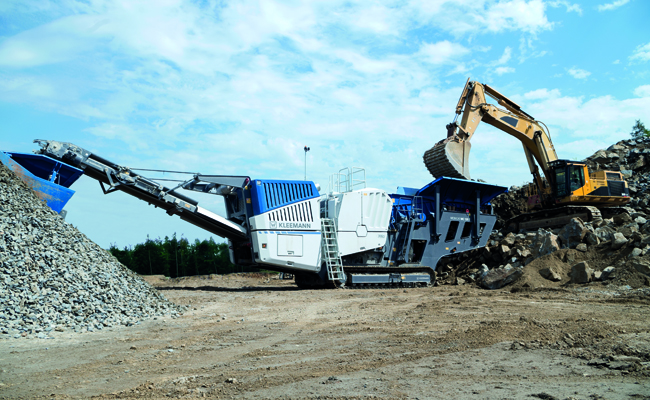
A large proportion of German sand deposits are located in nature reserves, residential areas and commercial zones, which is threatening an ‘artificial’ shortfall in supply.
Sand could soon be in short supply in Germany, according to the Federal Institute for Geosciences and Natural Resources (BGR).
The BGR says that geologically, there is no shortage of sand, gravel and natural stone deposits in the country, and quartz and construction sands can be found in sufficient quantities to cover domestic needs. Indeed, Germany was the biggest sand and gravel producer in the EU in 2016 with output totalling 247 million tonnes (out of the total EU 2016 production of 1,036 million tonnes), according to figures from the
However, the BGR warns that major bottlenecks in various regions of Germany are currently threatening substantial issues with supply. It adds that it is an ‘artificial’ shortage because a large part of sand deposits are located in nature reserves, or they lie under built infrastructure or in residential and commercial areas.
In addition, a similar large area of potential raw material deposits is already planned for other priority uses. The BGR says this means that it is inevitable there will be substantial difficulties regarding the extraction of raw materials for domestic construction.
“In some parts of Germany bottlenecks have already occurred in the past year, which were reflected in concrete that sometimes lasted several weeks, but also delays in delivery of road construction measures,” according to
MIRO says that companies are exploiting their current permits more quickly than had originally been forecast when the permits were granted. The result is that approvals are now coming to an end more quickly. On the other hand, mining permits in Germany - whether for expansions or new exploration - are now issued “restrictively” by the authorities. On top of this, new approval procedures are now more complex and thus more time-consuming.
In addition, the aggregates industry only ever produces the quantities and qualities that are on demand. “Our companies do not produce on heap,” says MIRO managing director Susanne Funk. For this reason, a lot of companies have adjusted their capacities to demand in the previously weak construction years. “Many companies closed their doors,” MIRO says.
MIRO is currently moving at a political level to raise awareness of what it says is the foreseeable – and potentially undesirable - production gap at the start of the construction supply chain.
“A shortage of aggregates and other construction raw materials would run counter to the goals of the federal government,” it states. “It is necessary to issue approval applications that have been submitted for a long time and to process new applications quickly. Germany is a country rich in raw materials used for aggregates. However, a corresponding precautionary approval practice should also provide the basis for the development of the aggregates [that are] in demand.”
In terms of total aggregates production Germany is comfortably the largest single producer in the EU with a figure of 572 million tonnes in 2016, according to the UEPG data. France was the second largest with 331 million tonnes, and the UK third with 259 million tonnes out of the EU total of 2,590 million tonnes.
There were 1,350 companies producing aggregates at 2,660 extraction sites (quarries and pits) in Germany in 2016. Crushed rock production totalled 218 million tonnes, marine aggregates were 10 million tonnes, recycled aggregates were 68 million tonnes, and manufactured aggregates were 29 million tonnes.
The outlook in terms of demand for crushed rock, sand and gravel in Germany is “positive”, according to MIRO. It states: “In Germany, almost four-fifths of the value-based production of construction raw materials goes into building construction, infrastructure construction and reconstruction. If the construction industry is doing well, there is also demand for sand, gravel and crushed rock products. This is currently the case. In Germany, construction investments grew by +2.7% in real terms in 2017. And the positive development in the construction sector continued in the first quarter of 2018, even though the rate of increase in construction investments in the first three months was comparatively low due to a cold wave in March 2018.”
For 2018 as a whole, MIRO says that a “positive development” in construction investments of around +2% in real terms is expected. It adds that the industrial sector, including the supply of materials such as quartz sand and quartz gravel, is also developing positively.
Demand for crushed rock went up by 0.9% in 2017 compared with the previous year, according to MIRO. Quartz gravel and sand demand increased by around 4.0% from 2016. However, part of this increase was likely due to the trend towards greater demand for higher quality aggregates.
| Estimates of German aggregates production (2016) | |
|---|---|
| Total number of producers (companies) | 1,350 |
| Total number of extraction sites (quarries and pits) | 2,660 |
| Sand & gravel (millions tonnes) | 247 |
| Crushed rock (millions tonnes) | 218 |
| Marine aggregates (millions tonnes) | 10 |
| Recycled aggregates (millions tonnes) | 68 |
| Re-used on site (millions tonnes) | 0 |
| Manufactured aggregates (millions tonnes) | 29 |
| Total production (millions tonnes) | 572 |
The positive trend in demand for aggregates is being driven both by residential construction and increasingly by road construction. For example, residential construction grew by 2.8% in 2017. Construction activity is still insufficient to meet the considerable demand for housing, especially in the metropolitan regions.
To fill this gap, the new Merkel government is working on a housing offensive, with 1.5 million new apartments to be built. A ‘Housing Summit’ took place in September 2018, and MIRO says it can be assumed that further political measures will be taken to support the positive trend in residential construction.
In terms of infrastructure, the German government committed to a number of road construction projects in the Federal Transport Infrastructure Plan 2016. The construction of federal highways is expected to expand significantly over the next few years. MIRO says that the good economic situation in Germany is providing financial resources for the budgets of federal states and municipalities. This means that increased investment is also expected in state and municipal roads over the coming years, with corresponding positive implications for aggregates demand.
MIRO cautions, however, that limiting factors on this expansion can already be seen: a shortage of both building sites and construction workers will have a dampening effect on the construction industry, and thus also on the demand for aggregates. MIRO therefore expects a positive, albeit less dynamic development in the demand for aggregates in the current year.
German quarrying original equipment manufacturer (OEM)
“We also think recycling in Germany will continue [to be] strong because of the focus to preserve Germany’s natural resources for longevity and to reduce the impact mining natural resources has on the environment,” Kleemann comments. “For example, our leading machine designs are focused on reducing the environmental impact by having one of the best overall fuel consumption [levels] in the industry.”
The company says it is seeing a big demand in Germany for tools that help effective utilisation of its equipment, including features that the machine executes automatically. It gives the example of the Kleemann continuous flow system, where the machine detects via ultra sonic probes the filling level of the crusher chamber and regulates the feed of the material accordingly.
All eyes will be on Germany next spring when the massive
For 2019, the site at
“Two new halls and a site structure that is even clearer - we have further optimised the parameters for our next bauma,” says Klaus Dittrich, chairman and CEO of Messe München.
The exhibition will feature an indoor space of 200,000m2 and will span (indoors and outdoors) more than 614,000m2. By comparison the last edition in 2016 had 605,000m2.
Dittrich says that, due to the clear division of the individual exhibition sectors, visitors can be managed in a more targeted way. With the two new halls together covering 20,000m², bauma will provide space for more exhibitors than in 2016, when 3,425 exhibitors took part.
The most important changes being made for 2019 will see the largest sector - construction machines and attachments - being expanded from four to five halls as well as by an additional area outdoors, directly adjacent to the hall complex. The components sector now also has five instead of four halls; formworks and scaffolds move to Hall B3; and lifting appliances are bundled in Hall C4. New in Hall C6 is the Conference Center North that houses additional conference rooms.
Previously located in Hall B0, the special “THINK BIG!” exhibit that shows students career opportunities in the construction and building material machine industries moves to the ICM – International Congress Center Munich.
It is also planned that, during the trade fair, the traffic-calmed part of Paul-Henri-Spaak-Straße will be turned into the “bauma Boulevard” pedestrian zone where visitors and exhibitors can enjoy international culinary offerings.









